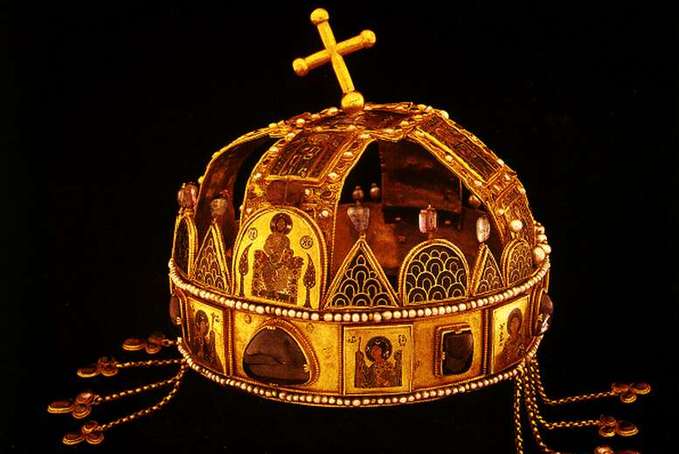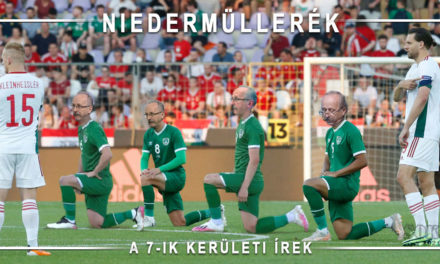As can be read elsewhere, Ulászló I was crowned with the crown that until then adorned the head reliquary of St. Stephen, which was taken from the tomb in the Székesfehérvár basilica.
In the charter dated July 17, 1440, the Diet talks about the right to elect a king and the right to transfer royal power, as well as the idea of the Holy Crown, depriving the Holy Crown of its "validity, any significance, mystery and power" until it is lost, at the same time transferring it to properties to said relic. They did this because Albert's infant son, who died in 1439, was not suitable for the given situation, Ulászló was "the suitable king".
Let's continue to follow Bartoniek's lines:
"So the Holy Crown goes on a new journey - to put it faithfully, symbolizing the unfortunate split that occurred in the possession of the Hungarian royal power at that time, and ended only with the accession of Mátyás and his coronation in 1464. It is not entirely certain where Queen Elizabeth hid and sent the Holy Crown, but what is certain is that after a rather tumultuous journey, the dowager Queen Mother finally gave it to the Roman-German King Frederick of Habsburg, his relative, as a pledge for 2,500 Hungarian forints ! This is the greatest humiliation that our Holy Crown has suffered during its nine hundred year history: it migrates to Hainburg Castle near Vienna as a pawn, and remains on Austrian soil and hands for 24 years. Of course, Frigyes - ostensibly as László V's guardian, for this purpose - does not want to issue the Holy Crown, not only to Ulászló I, but also to his protégé, László V, when he actually takes over Hungary in January 1453.
With this, Frigyes openly declared that he wanted to acquire Hungary for himself. However, in 1464 - in part II. Pope Pius , also under the pressure of the famous Aeneas Sylvius Piccolomini, who before his papacy III. He was in the service of Frederick - yet he is forced to hand over our Holy Crown to King Matthias . We can't go into detail here about the delay and hesitation with which Frigyes delayed the return of our Holy Crown, and even wanted to outplay it. Mátyás had to pay a high ransom to Emperor Frederick, 80,000 frts, so thirty-two times the 2,500 frts that his relative Elizabeth, who was in financial difficulty, received from Fredericks for the Holy Crown.
The undeserved fate that the Holy Crown had to suffer during the last twenty-four years prompted Mátyás and the citizens of the country to take care of the proper protection of the Holy Crown by law from now on. Right after the coronation in 1464, the Parliament required by law that the king ensure that the Holy Crown is guarded in a worthy place by suitable persons, lest, God forbid, it be alienated from the country again , as happened recently due to the unworthy and careless guarding of it, from which the country suffered irreparable damage and unspeakable losses, for which the Holy Crown had to be redeemed from the money of the country's community. (1464: II. t.-c.) That's all the law says, the implementation was apparently entrusted to the king, at that time very strict and detailed regulations were not yet customary in our laws. Rather, they set guidelines, which practice and governance apply as much as possible in the cases that arise and normally want to repair problems and violations of rights that have already happened.
After that, until the disaster of Mohács, no event worth mentioning happened with our Holy Crown: after the death of King Matthias, János Corvin , whom Matthias had designated as his successor, and who therefore kept the Holy Crown and the other insignia with him, readily handed them over to his more fortunate rival, the Czech king Ulászló I, to the second Hungarian king under this name, and even during his coronation, he himself, Mátyás' candidate for the throne, carried the crown in the procession. Two years after Ulászló's coronation, in 1492, his first code of laws dictates precisely where and who should guard the holy crown. (The great legislative period, the era of Werbőczy, has come, and seven law books have survived from Ulászló's fifteen-year reign.) Thus, Article 3 of 1492 orders – here the parliament is speaking, in the first person, not the king, as in the laws of Mátyás – , that from now on the crown will be guarded - as before - in the strong castle of Visegrád, by two crown guards, who will be chosen by the parliament from among its members. The actual guard of the Holy Crown and the coronation insignia was, of course, the captain of the Visegrád Castle, to whom the Crown Guards, chosen from time to time, handed over the Holy Crown against a written acknowledgment. In 1498, the 25th article orders that the crown guards should not be priests, but secular barons, and in 1500, the 23rd article stipulates that only two crown guards should be chosen from among the secular lords, the king, the barons, prelates and the other nationals together.
Before the disaster in Mohács, the other coronation badges always followed the fate of the Holy Crown, except for the 24 years when our Holy Crown in Austria, III. Emperor Frederick , where the other badges were not taken. We have already mentioned above that among the coronation badges of that time, only the scepter, the royal apple and the royal mantle remain today.
We cannot leave the Middle Ages without mentioning the extraordinary importance that our Holy Crown acquired in Hungarian state and political life in the Middle Ages. This is already clear from what has been said so far, since we have already seen that the idea of the Holy Crown is even more important."
Let's continue from Bartoni:
The Hungarian Holy Crown and coronation insignia were not spared from minor or major adversities in the modern era either. János Zápolyai , who with Péter Perényi , the surviving sub-leader of the Mohács disaster, was the guardian of the Holy Crown at the time, had easy access to the traditional crown guarded in Visegrád. All the more so, because at that time he was still in the same party as Perényi, who went over to Ferdinand only after his coronation, taking the Holy Crown with him. After Ferdinand's coronation in Székesfejérvár, the Holy Crown was probably taken back to Visegrád, where it was still kept - apparently - in 1529. In this sad year, another shameful event happened to our Holy Crown: the Zápolya-partisan János Bánffi captured the crown guard Péter Perényi, who was fleeing from the Turks with the Holy Crown, and handed him over to Sultan Szulejmán, who had invaded Hungary at the time.












